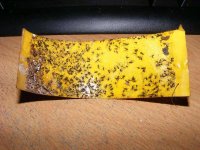L
LolaGal
Just picked up some dunks...it is my last effort to save one plant and keep the other two from getting as bad.
It is weird though, the other half of the plants don't seem affected by the gnats at all.
Now I just need to pick up a bug bomb at the hydro store.
good luck!
GREAT THREAD... very good idea. and here ive been using natrol every time i see the little jerks. LOL. you're gonna put natrol out of the game. Ill try the dunks next time.
Yup! Gnatrol is in big trouble!
I ordered Mosquito Bits the other day after talking to guy at the
cooperative extension office. He told me about this and also
mentioned a liquid product. I was buying the six pack of dunks at
Lowes for almost $10 and that's for 2.75 oz. So the bits are a good
savings.
JB
Yup, the bits are cheaper I hear, same thing better value, huh? good deal!
as long as those ole fungus gnats die! KILL EM Ya'll!






